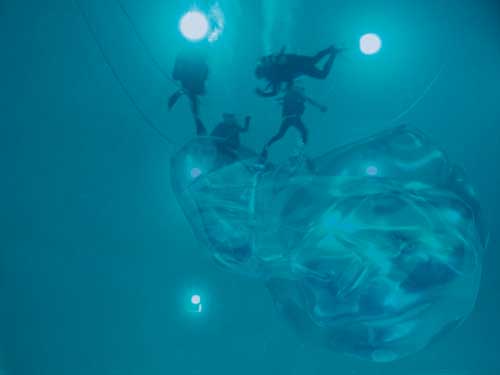
Inflation of hollows in a polymer lump floating under water
Videostill: Meogloea, 2003
The film was partly shot in a Neutral Buoyancy Facility, European Space Agency ESA, Cologne
Photo: Uwe Lierman and Industriesauger-tv, Cologne 2003
If we pour one fluid into another, the following phenomena will occur. If the liquids are mutually soluble they will mix creating a homogenous solution. If they are not mutually soluble they will be subjected to gravity: the heavier and denser (density = ratio between mass and volume) liquid will fall to the bottom, whereas the lighter liquid will move to the top, e.g. water and oil or water and paraffin.
[Die Experimente der D-2 Mission, Forum Weltraumforschung, RWTH Aachen Forum, 1993]
It is particularly interesting when two liquids have the same density and a drop of one of the liquids floats inside a drop of the other. This is the state of relative weightlessness.
Liquid dynamics can be observed in a lava lamp. Two mutually insoluble liquids, e.g. hydrophobic wax and hydrophilic isopropanol, are placed in a glass container. The liquids are of the same density, but have different thermal expansion coefficients. The specific cyclic movement occurs when the density of one of the liquids, e.g. the wax or oil, changes. This happens when the wax or oil is heated by a heat source installed at the bottom of the lamp and expands more than the other liquid. If its mass is stable it increases its volume, thus reducing its density, and moves upwards. As it travels away from the heat source it cools down, increases its density, falls to the bottom and repeats the cycle.
The Isopycnic Systems Project is aimed at creating forms under water in the neutral buoyancy phase. These are liquids within liquids, whilst the water comprises a fluid form for the polymer mass. The technology of fluid forms (© Lane Kluski Technology [Poached Dumpling Technology]) uses biological polymers with a similar density to that of water. Gelling matter is placed in water and floats in the liquid space being affected from all sides. Other liquids are injected inside it to change its shape and size, and to create isomorphous spaces and interiors. By proportioning liquids of lower density than that of gelatine and water inside the mass, it is possible to control its density and maintain it in a state of floating.
The isopycnic state enables the practical creation of unrestricted forms that display a diversity of amorphous shapes and architectural scale. This liquid technology offers new possibilities for creating amorphous forms generated in the virtual space of a computer.

material science
spatium gelatum
form as process
isopycnic system
breeding spaces
new soil
transgenic habitat
beyond gravity